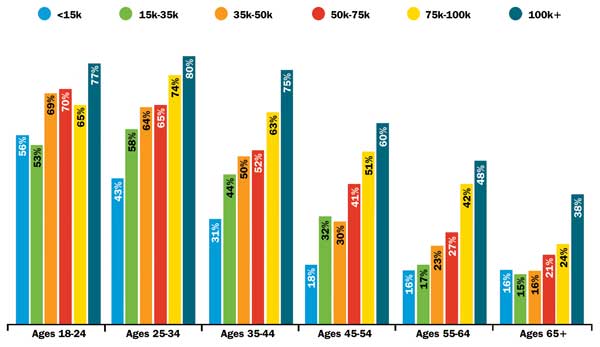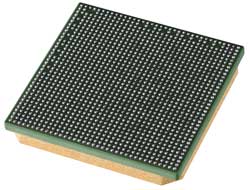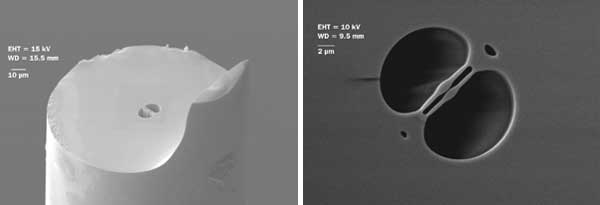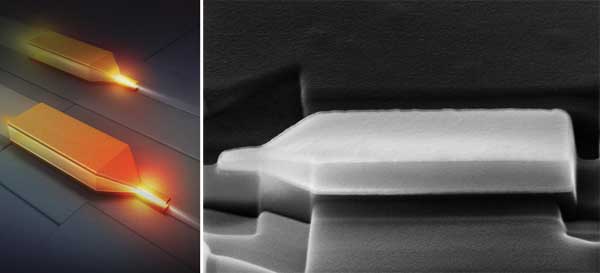Technological developments in photonics are the future of mobile communications, from speedy interconnects to novel types of fibers and lasers.
How remarkable that the first iPhone was released just over five years ago, back in the “dinosaur-phone era” of 2007. It was only 10 years ago that PDAs (personal digital assistants) were the hottest tool to organize a busy life, even though accessing the Internet with one, much less a phone, was limited and remarkably expensive.
Now, thanks to the phenomenal growth of smartphones and tablets, the demand for bandwidth is greater than ever, a fact that prompted the US to undergo a massive urban build-out of LTE (long-term evolution) wireless broadband networks. In late 2012, the US had 69 percent of the world’s 4G LTE subscribers, making it a global hotbed for LTE apps and services.1
Nearly half of American adults 181 and of all income ranges own smartphones, and the statistic is growing, according to recent reports from market research firm Nielsen and “fact tank” poller Pew Research Center.2 If the category is narrowed to adults ages 25-34 with incomes over $100,000 per year, about 80 percent own smartphones (Figure 1).

Figure 1. Smartphone ownership is closely correlated to age and income, according to a Nielsen survey taken in January 2012 of more than 20,000 US mobile users. In all categories, ownership of smartphones and tablets is growing so quickly that the lack of available spectrum is a significant looming problem.
Smartphones typically require data plans, the use of which flood networks with a prodigious need for bandwidth. Network provider Cisco estimates that the average tablet is even more demanding, generating 3.5 times more traffic than the average smartphone.3 This need for bandwidth is good in that it’s a massive economic driver. Mobile innovation is credited with creating more than 1 million jobs in the US since 2008, during the worst depths of the recession, according to Julius Genachowski, chairman of the US Federal Communications Commission (FCC).
“The faster we can connect our citizens, the faster our economy can grow,” he said. Theoretically, the closer to the speed of light we can talk and message – and upload and download documents, pictures, presentations and video – the more efficient we become. This bandwidth demand is good for photonics – in fact, photonics is critical – but high-speed broadband coverage also must be affordable and ubiquitous.
It’s in the air
The biggest problem limiting the growth of US mobile communications is the lack of available spectrum, Genachowski said.
“In June 2008, there was no app store,” he noted. “In June 2012, the Apple and Android app stores alone had a collective 3 billion downloads – that’s 100 million apps a day.” The airwaves are crowded with voice and data signals from radio, TV and mobile devices. With mobile traffic expected to grow sixteenfold by 2016, a spectrum crunch is inevitable. A comprehensive National Broadband Plan detailed by the FCC suggests auctions, dynamic sharing and regulatory solutions to free up portions of the spectrum in the coming years, which may be familiar to all who witnessed the recent digital TV transition.
With the right tweaks, the spectrum may be able to stand the mobile communications onslaught for years to come. However, key to the solution is innovation in optical technology, which has its place beyond the spectrum of radio- and microwave-frequency signals that are transmitted across free space at light speed. Once these signals begin interfacing with the wired network of businesses, data centers, switches, long-haul networks and cabling, they slow down to electron speeds. Optics can help speed them up. And as new parts of the spectrum are recruited for use, novel optical technology and devices
that operate at the new frequencies may help handle traffic more efficiently and, ideally, at a lower cost per bit.
Bandwidth is affected by factors in different parts of the optical network. Near the user end of the network, bandwidth is limited by the need to distribute data to millions of users via routers. Commercial interfacing solutions for gateways and routers in applications such as Carrier Ethernet and mobile backhaul are currently targeting a range of data rate protocols from 10GigE to 400G.
These hardware solutions are addressing the need for service providers and enterprises to scale to data rates of up to 2 Tb/s and beyond. At this end, many of the advances still lie in nonphotonic solutions. The electrons are made to move more quickly with more efficient use of real estate and advanced protocols for traffic routing and service management. However, even here, photonics has a place. Today’s network processors incorporate photonic technology such as photonic switches, vertical-cavity surface-emitting lasers, photonic waveguides and wavelength division multiplexing components.
One example of photonics in action is Alcatel-Lucent’s 400G Photonic Service Engine (PSE), an optoelectronics chip incorporated into the 1830 Photonic Service Switch, a key element of the company’s High Leverage Network architecture installed today in more than 120 core networks globally (Figure 2).

Figure 2. The 400G Photonic Service Engine (PSE) optoelectronics chip from Alcatel-Lucent is an important element in the company’s photonic switches and network architecture for core networks. The 400G PSE can transmit more than 23 Tb/s of data along a single optical fiber, increasing 100G reach to 3000 km without regeneration.
The 400G PSE enables more than 23 Tb/s of data to be transmitted along a single optical fiber (a 2.6x increase) and can extend 100G reach by more than 50 percent – from 2000 to 3000 km without regeneration – while reducing both power consumption per gigabit and footprint by 33 percent.
The PSE offers configuration flexibility that enables optimized optical parameters that adjust to varying conditions in the field. The 1830 switch itself has a terabit switching capacity based on tunable/reconfigurable optical add-drop multiplexer technology on more than 88 channels at 2.5G, 10G, 40G and 100G.4
It’s in the fiber
New types of optical fibers are of particular interest for their ability to move data at the speed of light across hundreds of meters to kilometers. Researchers at the University of Southampton in the UK have developed a dual-core optical fiber that can speed up the bottlenecking that occurs in switches, routers and buffers (Figure 3). The nanomechanical fiber not only transmits light, but also controls nanometer-scale mechanical movements in the core that act as a directional coupler in response to applied pressure.5

Figure 3. A dual-core nanomechanical optical fiber fabricated at the University of Southampton (left) is sensitive to pressure changes, enabling nanometer-scale displacements in the core’s dual-slab fiber (right) that may allow optical switching of light from one core to the other. WD 5 working distance; EHT 5 electron high tension.
The team directly fabricated low-loss submicron optical fibers on a draw tower with a conventional 125-µm glass cladding for protection and multiple fiber cores inside the cladding for optical and mechanical interaction. Low-loss transmission over hundreds of meters should be possible, the team says, and the dual suspended controlled-movement core of the fiber opens up novel possibilities in self-configurable fiber optics, switching and optical buffering.
Researchers also are actively developing hollow-core fibers to reduce nonlinear refraction effects that occur over long distances in glass fiber. Previous attempts to commercialize hollow-core fiber targeted the common communications transmission wavelength of 1550 nm. Although these attempts failed, the large team assembled at the Engineering and Physical Sciences Research Council (EPSRC) Center for Innovative Manufacturing in Photonics and at the Optoelectronics Research Centre, both at the University of Southampton, is researching the feasibility of various types of optical fiber for telecom and the fabrication and manufacturability of these fibers. The thrust of the research is fiber for wavelengths longer than 1550 nm, said Wei Loh, deputy director at the EPSRC center.
“Though the nanomechanical fiber is not intended for high-speed, long-distance transmission,” Loh said, “another aspect of our research effort is directly aimed at improving the performance – bandwidth, data rate, loss – of long-distance transmission fibers, potentially by up to a thousandfold.”
Although silica doesn’t transmit well at longer infrared wavelengths, air does.
“A key attraction for operating in the 1550-nm window has been the erbium-doped fiber amplifier, or EDFA,” Loh said. “However, after a quarter of a century, the EDFA amplification bandwidth of about 100 nm has stayed nearly the same. Where the EDFA was once an elegant solution, we increasingly view it as a bottleneck, as bandwidth and data rate requirements continue to increase rapidly.
“Since the EDFA has little prospect of expanding its gain bandwidth significantly – one can only do so much with modifying the behavior of erbium in glass – it is time to research longer-wavelength-transmission windows.”
Another alternative is the thulium-doped fiber amplifier, which the team hopes to use with its hollow-core and novel nanomechanical fibers.
The EPSRC recently awarded a “Photonics Hyperhighway” research grant of nearly £7 million (about $11 million) to the Southampton team to develop hollow-core photonic bandgap optical fibers for ultrahigh-bit-rate, long-distance transmission. Successful development of a fiber with a thousandfold performance improvement would enable novel optical components that eventually could be adopted into networks and network architecture.
The first low-loss hollow-core bandgap fiber suitable for transmitting high-data-rate signals demonstrated by Southampton had a bandwidth of 8 Gb/s in an optically amplified data channel at 2008 nm.6 The researchers showed that the single-mode fiber could someday handle a lot more bandwidth while being compatible with a thulium-doped fiber amplifier instead of an EDFA, making it a viable option for future generation systems.
Scientists also are exploring nanoscale light sources such as the nanoLED and nanolaser for next-generation communications. The goal of nanoscale light sources is faster modulation rates, lower power consumption and a smaller size, said Hyuck Choo, assistant professor of electrical engineering at California Institute of Technology in Pasadena. To accomplish these goals, highly efficient nanoscale focusing and confinement are essential but complicated by diffraction limits.
To that end, Hyuck and colleagues developed a technique for nanofocusing beams of light into extremely small devices.7 They fabricated a AuSiO2Au gap plasmon waveguide with a 3-D taper measuring only 100 nm across (see Figure 4). Simulations predict that this 3-D nanoplasmonic photon compressor could focus 830-nm light into a 2 x 5-nm area with less than 3 dB of loss and an intensity enhancement of 3 x 104.

Figure 4. An on-chip 3-D nanoplasmonic photon compressor would work like a nanofocusing waveguide (illustration, left) to funnel light from a fiber optic network into nanoscale devices such as those required for next-generation quantum computing. A fabricated version of the 3-D nanoplasmonic photon compressor (SEM image, right) is 1.5 µm long. At its focus, the intermediate dielectric layer of SiO2 between gold layers measures just 80 x 14 nm.
“We believe that the nanofocusing properties of our device are far more promising than other techniques (such as photonic crystals) being explored,” Choo said, “and most likely it would take considerably less than 10 to 15 years to build practical devices. Most importantly, our device already has an on-chip form and is made mostly using thin-film processes.”
The device can be used to create an efficient single-photon source or detector for quantum computing, in which single-photon detection, confinement and focusing will be essential. And therein lies an enticing future: ultraefficient quantum computers that would radically shorten the time needed to perform complex processes and send data, drastically reducing the amount of bandwidth required per bit.
References
1. J. Genachowski (2012). Winning the global bandwidth race: opportunities and challenges for mobile broadband; prepared remarks, University of Pennsylvania, Wharton, October: http://www.fcc.gov/document/chairman-genachowski-winning-global-bandwidth-race.
2. http://blog.nielsen.com/nielsenwire/?p=30950.
3. Cisco VNI Global Mobile Data Traffic Forecast, 2012. http://bit.ly/UmRm9G.
4. Alcatel-Lucent white paper (2012). The 400G Photonic Service Engine: http://bit.ly/TL8F5P.
5. Z. Lian et al (Dec. 31, 2012). Nanomechanical optical fiber. Opt Expr, Vol. 20, pp. 29386-29394. http://bit.ly/TL8R5f.
6. M.N. Petrovich et al (2012). First demonstration of 2µm data transmission in a low-loss hollow core photonic bandgap fiber. Proc ECOC, Munich.
7. H. Choo et al (December 2012). Nanofocusing in a metal-insulator-metal gap plasmon waveguide with a three-dimensional linear taper. Nat Phot, Vol. 6, pp. 838-844. http://bit.ly/VycZY7.